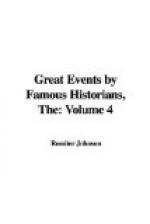A.D. 529-534
EDWARD GIBBON
The richest legacy ever left by one civilization to another was the Justinian Code. This compilation of the entire body of the Roman civil law (Corpus Juris Civilis), as evolved during the thousand years after the Decemvirate legislation of the Twelve Tables, comprises perhaps the most valuable historical data preserved from ancient times. It presents a vivid and authentic picture of the domestic life of the Romans and the rules which governed their relations to each other. This phase of history is considered by modern historians as of far greater importance than the chronicles of battles and court intrigues.
The importance of the Justinian Code, however, is not that of mere history. Its influence as a living force is what compels the admiration and gratitude of mankind. It forms the basis of the systems of law in all the civilized nations of the world, with the exception of those of the English-speaking peoples, and even in these the principles of the civil law—as the Roman law is called in contradistinction to the common and statute law of these nations—form the most important part of the regulations concerning personal property.
For this monumental work the world is indebted to Justinian I (Flavius Anicius Justinianus), the most famous of the emperors of the Eastern Empire since Constantine. He was born a Slavonian peasant. Uprawda, his original name, was Latinized into Justinian when he became an officer in the Imperial Guard. He was adopted, educated, and trained by Justin I, whom he succeeded as emperor. His long reign (527-565) was disturbed by the sanguinary factions of the Circus—the Greens and the Blues, so named from the colors of the competing charioteers in the games—the suppression of the schools of philosophy at Athens, and by various wars. Nevertheless it was marked by magnificent works, the administrative organization of the empire, and the great buildings at Constantinople. The Church of Santa-Sophia, the first great Christian church, although used as a Mahometan mosque since 1459, still stands at Constantinople, with its plain exterior but impressive interior, a monument of Justinian’s reign.
His two great masters of war, foreigners in origin like himself, were Belisarius the Thracian and Narses the Armenian. Africa was wrested from the Vandals; Italy from the successors of Theodoric; and much of Spain from the Western Goths. Under Justinian the Byzantine or Eastern Empire resumed much of the majesty and power of ancient Rome. But the crowning glory of his career was the Code. One of the greatest historians says of his reign: “Its most instructive lesson has been drawn from the influence which its legislation has exercised on foreign nations. The unerring instinct of mankind has fixed on this period as one of the greatest eras in man’s




